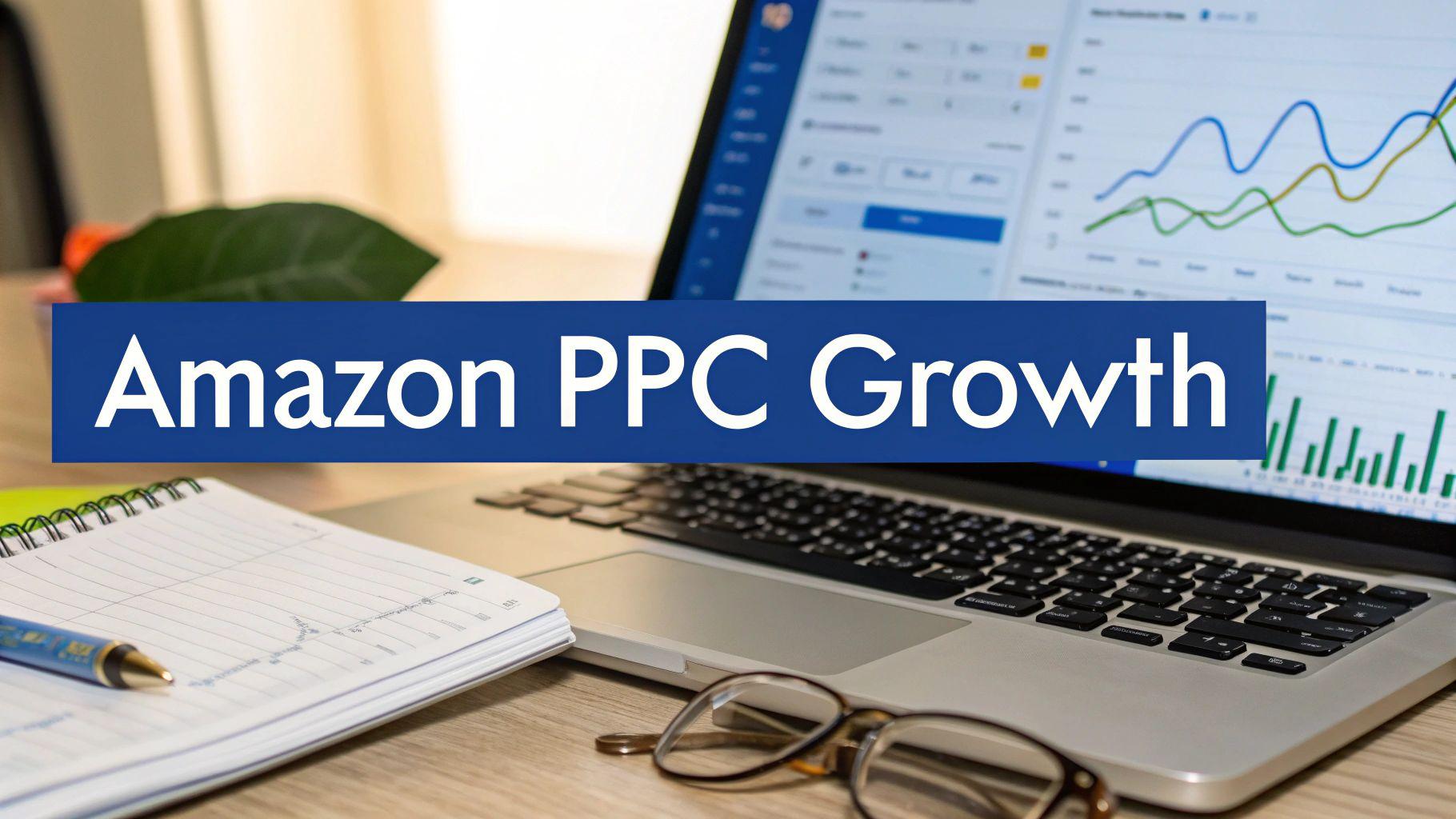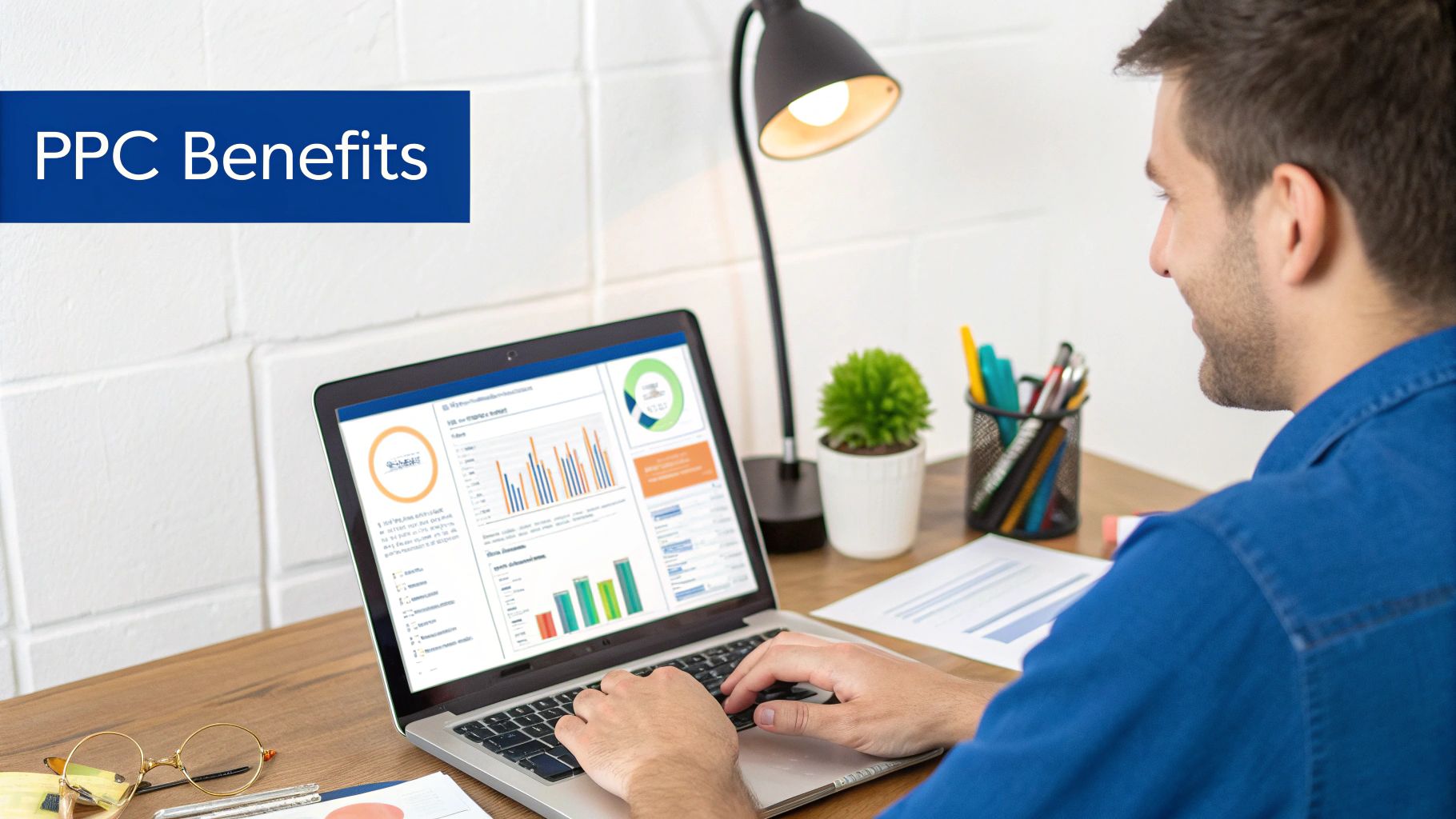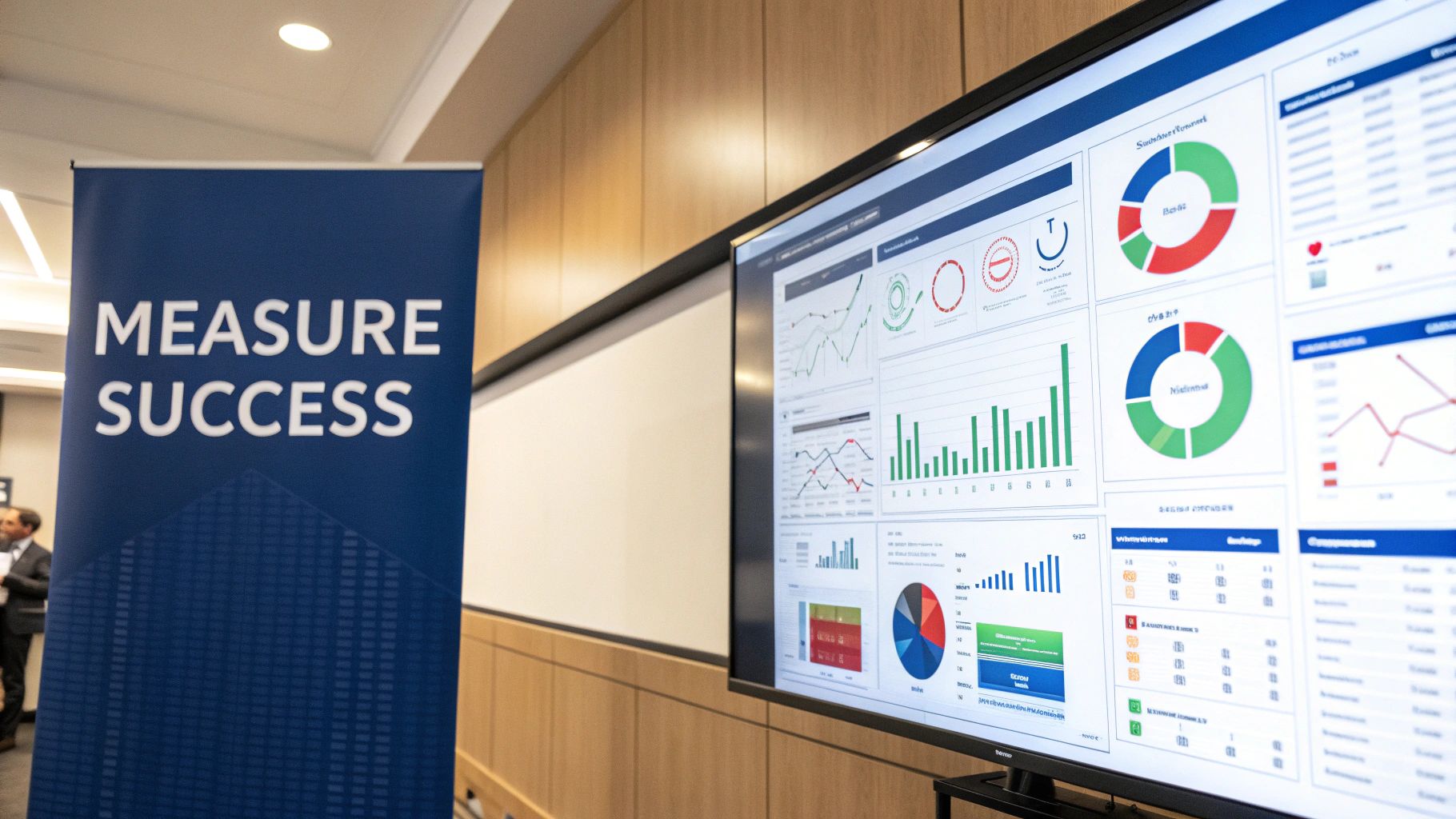Amazon PPC Management Service: A Guide to Driving Sustainable Growth
Discover how a performance-first Amazon PPC management service drives real growth. Learn to choose the right partner and scale your brand profitably.

What is an Amazon PPC management service? It's a strategic partnership designed to run your paid advertising campaigns on Amazon's platform. This extends far beyond simple bid adjustments. It's a data-intensive service focused on driving sales, improving profitability, and, most critically, leveraging paid media to boost your organic search rankings and achieve sustainable scale.
Why Performance-First PPC Is Your Ultimate Growth Engine
Many eCommerce leaders view Amazon PPC as a cost of doing business—an expense line required to purchase visibility. This is a limited, and ultimately costly, perspective. A modern Amazon PPC management service doesn't just manage ad spend; it converts that budget into a powerful, self-sustaining growth engine for your entire brand on the platform.
It's the difference between treading water and creating a current that propels you forward. This isn't just about lowering your Advertising Cost of Sale (ACoS). It's about building a scalable, profitable business. A performance-first approach uses paid ads as a lever to influence Amazon's A9 algorithm, which in turn has a direct and measurable impact on your organic success.
From Cost Center to Profit Driver
The essential mindset shift is from asking, "How much are we spending on ads?" to "What is our ad spend achieving for the business as a whole?" A top-tier service operates less like a vendor and more like a strategic partner, focused on the key performance indicators (KPIs) that build long-term enterprise value, not just short-term ad efficiency.
This strategic approach is becoming non-negotiable. The global market for PPC management services is projected to reach an estimated $25 billion by 2033, with an 11.5% compound annual growth rate. This growth is driven by brands recognizing the need for expert guidance to cut through intense competition and leverage sophisticated tools to achieve a clear return on investment. You can learn more about the market's trajectory and how AI is shaping campaign outcomes.
The Real Goal of Amazon Advertising
Ultimately, the objective isn't just to sell products with ads. It's to ignite a flywheel where advertising provides the initial, powerful momentum.
A well-executed PPC strategy does more than generate immediate sales; it feeds critical data points like sales velocity and conversion rates directly to Amazon’s algorithm. These signals improve organic ranking, creating a positive feedback loop that reduces ad dependency over time.
This integrated approach means every dollar of ad spend is also an investment in your brand's organic moat. The data from your campaigns should inform critical business decisions beyond advertising, including:
- Inventory Planning: Using search volume and trend data to forecast demand more accurately.
- Product Launches: Engineering the initial sales velocity required to gain organic traction quickly.
- Competitive Defense: Shielding market share by strategically targeting and outmaneuvering competitors.
The Takeaway: Stop viewing PPC in a silo. An expert Amazon PPC management service integrates your ad strategy with core business objectives, transforming advertising from an expense into your most reliable engine for profitable, long-term growth.
The Anatomy of a Winning Amazon PPC Service

What does an elite Amazon PPC management service actually execute? It's far more than tweaking bids and delivering reports. A high-performance partner acts as a dedicated growth team for your brand, fine-tuning the entire advertising engine to drive profitability and sustainable scale. They view your campaigns as a critical lever for growth.
A truly strategic service doesn't just chase a low ACoS. They architect and execute a sophisticated strategy built on three pillars: brand defense, market share expansion, and profit maximization. This is a dynamic operation that uses data to win in competitive landscapes.
It begins with an intelligent, multi-layered campaign structure. Forget basic auto and manual campaigns. An expert designs a system that segments keywords by match type, targets shoppers at different stages of the buying funnel, and builds distinct campaigns aligned with specific business goals.
Advanced Keyword and Targeting Tactics
The core of any successful PPC strategy is mastery of keywords and targeting. A premier service goes far beyond pulling a simple search term report. They employ advanced methodologies to ensure every dollar of ad spend is maximized for impact.
This is a continuous, proactive process:
- Perpetual Keyword Harvesting: Constantly mining data from auto campaigns, search query performance reports, and competitor intelligence to uncover new, high-converting customer search terms. This is an ongoing offensive maneuver.
- Strategic Competitor Conquesting: Actively targeting competitor ASINs and branded keywords to intercept their customers and capture market share. In a recent case study, a brand in the competitive home goods space saw a 32% lift in category sales by implementing a targeted ASIN conquesting strategy.
- Defensive Brand Moat: Building a fortress around your brand by creating campaigns that dominate ad placements for your own branded searches. This prevents competitors from poaching your high-intent customers at the point of purchase.
A common mistake is treating all keywords equally. A seasoned strategist segments them with surgical precision, separating broad, top-of-funnel discovery terms from high-intent, bottom-of-funnel "buy now" keywords, and budgets accordingly to prevent wasted spend on non-converting traffic.
Beyond Clicks: Focusing on Total Business Growth
Ultimately, a top-tier Amazon PPC management service is accountable for improving your total business performance, not just ad metrics. The conversation must evolve from a narrow focus on ACoS to the far more meaningful metric: Total Advertising Cost of Sale (TACoS).
TACoS measures ad spend against total revenue (ad-generated + organic). This KPI provides the true story of how PPC efforts are fueling overall growth.
This approach is designed to create a virtuous cycle. Strategic ad spend drives incremental sales, which boosts organic rank. Improved organic rank drives more "free" sales, which lowers TACoS and increases overall profitability. This is the flywheel in action.
A strategic partner will report on metrics that demonstrate this holistic impact, such as:
- Organic Rank Fluctuation for Core Keywords: Directly correlating ad-driven sales to improved organic visibility.
- Share of Voice (SOV): Tracking your brand's footprint on the digital shelf against key competitors.
- New-to-Brand Customer Acquisition: Using advertising to acquire new customers and measuring their lifetime value (LTV).
For a closer look at how these components integrate, our guide on comprehensive Amazon PPC management offers more detail. The right partner won't just report numbers; they will connect those numbers to tangible business outcomes, proving their value and justifying the investment in strategic growth.
How to Choose the Right PPC Management Partner
Selecting the right partner for Amazon PPC is a critical decision for an eCommerce leader. You are not merely outsourcing a task; you are entrusting them with your brand's growth engine. The wrong choice leads to burned ad spend and stagnant growth. The right partner becomes a catalyst for scalable success.
This requires vetting beyond surface-level questions about target ACoS or reporting frequency. A truly strategic partner understands how paid advertising fuels the entire Amazon flywheel and speaks the language of profitability, market share, and long-term brand equity.
To differentiate the strategists from the tacticians, use this framework to guide your evaluation.
Vetting for Strategic Depth
The first filter is identifying whether a potential partner demonstrates a holistic understanding of the Amazon ecosystem. Can they articulate the connection between PPC campaigns and your overarching business objectives?
Pose questions that demand strategic thinking:
- "How do you measure and report on the impact of PPC on our organic sales and keyword rankings?" A strong answer will immediately reference TACoS (Total Advertising Cost of Sale) and their process for monitoring organic rank changes. This proves they see PPC as a lever for total growth.
- "Walk me through an example of how you defended a client's market share against an aggressive new competitor." This forces them to demonstrate proactive, defensive thinking, not just reactive optimization.
- "What is your process for feeding campaign insights back to our team to inform inventory planning or new product development?" A great partner views PPC data as a source of business intelligence that provides value across the organization.
The goal is to cut through sales jargon. You are seeking evidence of a proactive, data-driven methodology focused on your P&L, not just a promise to lower ad costs.
When transitioning from in-house management to a specialized service, the impact should be substantial and measurable across multiple fronts.

As this illustrates, the objective is not just improved ad performance, but a significant return on investment and the liberation of valuable internal resources.
Comparing Management and Pricing Models
Amazon PPC management services are not one-size-fits-all. The engagement model—and its associated cost—must align with your brand's scale, budget, and internal capabilities. Understanding these structures is key to making a sound financial decision.
Three models are most common in the market. Each has distinct advantages and disadvantages.
Comparing Amazon PPC Management Service Models
| Model | Best For | Typical Cost Structure | Key Advantage | Potential Downside |
|---|---|---|---|---|
| Percentage of Ad Spend | Established brands with significant, fluctuating ad spend. | 10-15% of monthly ad spend. | Scales simply and directly with advertising investment. | Can create a misalignment, incentivizing spend over efficiency. |
| Flat Monthly Retainer | Brands seeking predictable costs and consistent, dedicated strategic oversight. | $2,000 - $10,000+ per month. | Budget predictability; focuses the partner on achieving agreed-upon KPIs. | Fee is fixed, regardless of monthly performance fluctuations. |
| Hybrid Model | Growth-oriented brands wanting to directly align partner incentives with business outcomes. | A lower flat fee plus a performance bonus (e.g., % of revenue growth). | Creates a true partnership where both parties win from growth. | Can be more complex to structure and accurately track. |
A final word of caution: be skeptical of providers offering rock-bottom pricing. Premier strategic work requires senior talent and sophisticated tools, which carry a cost. The superior investment is nearly always with a partner who charges a fair price and delivers a clear, measurable return on total profitability and market share—not just ad spend.
Fueling the Flywheel: How PPC Drives Organic Success

The defining concept that separates amateur sellers from professional operators on Amazon is the "flywheel." Many see paid advertising and organic sales as siloed activities. This is a fundamental error. Any expert Amazon PPC management service knows the truth: paid advertising is the catalyst that ignites the organic growth engine.
Amazon's A9 algorithm is, at its core, a relevance engine designed to maximize customer satisfaction and revenue. Its primary function is to surface the products shoppers are most likely to purchase. When your PPC ads generate consistent sales for a specific keyword, you are sending an undeniable signal to Amazon: this product is highly relevant for this search query.
In response, the algorithm begins to reward your product with improved organic ranking for that same keyword. This initiates a powerful virtuous cycle—the flywheel effect. Your initial ad-driven sales create organic visibility, which drives more non-paid sales, which further solidifies your high ranking, creating a sustainable asset.
The Algorithm and Sales Velocity
The fuel for this flywheel is sales velocity—the rate at which your product sells. A targeted PPC campaign is the most effective tool for generating this initial velocity, particularly for new product launches or when targeting new, competitive keywords.
This early momentum provides the critical first push to the flywheel. Without it, even a superior product can languish on page ten of the search results, invisible to both customers and the algorithm. A strategic PPC launch campaign acts as the accelerant, proving your product's viability to Amazon and earning that crucial page-one visibility.
The Takeaway: Your ad budget isn't just buying clicks; it's buying data and influence. You are training the Amazon algorithm to favor your product. Every ad-driven sale is an investment in your long-term organic rank, building an asset that generates returns long after a campaign ends.
A Real-World Flywheel Example
Consider the launch of a new premium espresso machine in a saturated market. With zero sales history, organic visibility is nonexistent. A strategic Amazon PPC management service would execute a phased launch plan:
- Phase 1 - Aggressive Seeding (Weeks 1-4): The sole objective is generating sales velocity. The campaign aggressively targets a tight group of high-intent keywords like "burr coffee grinder" and "espresso machine for home." Profitability (ACoS) is a secondary concern; the mission is to generate enough sales volume to signal relevance to the A9 algorithm. For a client in the electronics category, this strategy resulted in achieving page one, position seven ranking for their primary keyword within 28 days.
- Phase 2 - Rank Stabilization (Weeks 5-8): As the product achieves organic ranking on pages two or three, the ad strategy pivots. Spend continues on core terms to maintain momentum and solidify the new organic position, pushing toward page one.
- Phase 3 - Profitability and Scale (Weeks 9+): With the product now ranking on page one, the flywheel is self-sustaining. Organic sales provide the baseline velocity. Aggressive ad spend on primary keywords can be scaled back, and the PPC budget is reallocated to brand defense and expansion into new, long-tail search terms for incremental growth.
The result? The initial PPC investment not only generated revenue but secured a valuable, long-term organic ranking that will continue to drive traffic and sales with minimal ad support. This is a clear example of how to strategically increase Amazon sales by creating synergy between paid and organic channels. This process is amplified by Amazon's high-intent user base; with an average platform-wide PPC conversion rate around 10.33%, PPC is the ideal fuel for the flywheel, but it demands precise management to be effective.
A top-tier Amazon PPC management service does more than manage ads. They architect and operate the flywheel, converting ad spend into a durable business asset that reduces advertising dependency and builds a more profitable, defensible brand.
Measuring What Matters: Beyond ACoS
For too long, the Amazon PPC conversation has been dominated by a single metric: Advertising Cost of Sale (ACoS). This narrow focus is a strategic blind spot. While ACoS measures ad efficiency, obsessing over it is like evaluating a company's success based solely on its office rent expense. It ignores the bigger picture of revenue, growth, and profitability.
A sophisticated Amazon PPC management service understands that success is measured by the overall health of your business on the platform. To engage in productive, performance-focused conversations with your PPC partner, you must elevate the discussion beyond simple cost metrics to strategic growth drivers.
Moving from ACoS to TACoS
The most critical shift is adopting Total Advertising Cost of Sale (TACoS) as your North Star metric. Where ACoS measures ad spend against ad-generated revenue, TACoS provides a holistic view. It measures your total ad spend against your total revenue—both paid and organic.
TACoS = Total Ad Spend / Total Revenue (Paid + Organic)
This single KPI immediately reveals the true impact of your advertising investment. A decreasing TACoS over time is the clearest indicator that your PPC campaigns are successfully fueling the flywheel, improving organic sales, and making your business more profitable and less reliant on paid media.
KPIs for a Holistic View
Beyond TACoS, a performance-driven dashboard should track several other leading indicators of brand health. A proactive agency will report on these metrics to demonstrate how their work is building enterprise value.
- Change in Organic Rank: Are your ads measurably improving your organic position for high-value keywords? This directly links ad-driven sales velocity to algorithmic favor.
- Share of Voice (SOV): What percentage of the digital shelf does your brand command versus your top competitors? Growing SOV is a direct measure of market share expansion.
- New-to-Brand (NTB) Customer Metrics: What is your cost to acquire a new customer via advertising? This is crucial for understanding long-term profitability and customer lifetime value (CLV).
The Amazon opportunity is immense. The platform generated approximately $46.9 billion in advertising revenue in 2023, a 24% year-over-year increase. As its U.S. market share approaches 40%, competition intensifies, making expert PPC management essential for navigating the complex data landscape. You can discover more insights about Amazon's growth on ecomclips.com.
These advanced metrics provide a far richer and more accurate narrative than ACoS alone. They help you understand your return on ad spend in terms of brand equity, market position, and sustainable profit. To dive deeper into this framework, check out our guide on how to calculate return on ad spend.
The Takeaway: Demand a reporting framework that moves beyond ACoS. By focusing on KPIs like TACoS, organic rank, and Share of Voice, you ensure your ad budget is not just buying clicks—it's building a dominant and profitable brand on Amazon.
Common Questions About PPC Management Services

Engaging an external partner is a significant business decision. As an eCommerce leader, you require direct, no-nonsense answers to make an informed choice. Here are the most common questions we hear from brand principals, answered from a practical, performance-first perspective.
How Long Does It Really Take to See Results?
This is the most frequent question, but the answer isn't about instant gratification. While quick wins are possible, a truly effective Amazon PPC management service focuses on building sustainable, long-term growth, not just delivering a temporary reduction in ACoS.
A realistic performance timeline follows a structured progression:
- Month 1 (First 30 Days): Foundation & Restructuring. This initial phase is dedicated to a deep-dive audit, data analysis, and a complete rebuild of campaign architecture. The primary goal is establishing a solid, scalable foundation. Early efficiency gains may be visible, but this is setup, not optimization.
- Month 3 (After 90 Days): Momentum & Positive Trends. By the end of the first quarter, the impact should be clearly measurable. You should see significant positive trends in key metrics—not just ACoS, but more critically, improving organic rank for target keywords and a declining TACoS.
- Month 6 (After 180 Days): Demonstrable ROI & Scale. This is where the flywheel effect becomes undeniable. Growth should be consistent and sustainable, evidenced by a steadily decreasing TACoS, increased organic sales, and measurable gains in market share.
A strong partner will present a detailed 30-60-90 day plan that shifts the conversation from "How fast?" to "How do we build a durable competitive advantage?"
What Should a Quality PPC Management Service Cost?
Pricing for an Amazon PPC management service varies, but credible agencies typically use one of three models: a percentage of ad spend, a flat monthly retainer, or a hybrid structure. For established brands, expect retainers to begin around $2,000 per month and exceed $10,000 for larger, more complex accounts.
The most significant error is viewing cost in a vacuum. A cheap service that merely manages ACoS is an expense. A premium service that actively grows total profitability and market share is an investment that delivers a multiple on its cost.
Be highly skeptical of pricing that seems too good to be true. It is often a red flag for a lack of strategic depth, junior account management, or a "set-it-and-forget-it" approach reliant on basic automation. The intelligent evaluation weighs cost against the tangible enterprise value and P&L growth it generates.
Will an External Service Understand My Brand?
The right partner will. Top-tier agencies operate as a genuine extension of your team, not as a disconnected vendor.
This is accomplished through a structured discovery and onboarding process:
- They conduct deep-dive sessions to understand your brand DNA, product catalogue, competitive landscape, and core business objectives.
- They integrate your brand guidelines, historical marketing efforts, and customer personas to ensure all creative and copy is authentic and on-brand.
- They establish a regular cadence of strategic calls and performance reviews, creating a collaborative feedback loop where insights flow in both directions.
The most successful agency relationships are strategic alliances. You provide the irreplaceable brand and product expertise; they provide the specialized Amazon PPC knowledge and execution capability.
What Is the Biggest Mistake Brands Make When Hiring?
Without question, the biggest mistake is hiring a service with the sole objective of lowering ACoS. This narrow mandate forces an agency to operate defensively. They will inevitably slash bids, pause valuable discovery campaigns, and starve the brand of the advertising fuel required for growth.
This "safe" strategy is a recipe for long-term decline. While you are "saving" money on ads, competitors are acquiring your customers and eroding your market share. Your organic rank and total sales will eventually suffer.
The smarter approach is to redefine the objective.
- Prioritize TACoS (Total Advertising Cost of Sale): Make this your North Star KPI to ensure PPC efforts are growing the entire business.
- Empower Strategic Spend: Authorize your partner to run a portfolio of campaigns with diverse objectives. Some will target profitability, while others will be built for brand defense, new product launches, or market share conquest—each with a distinct and appropriate ACoS target.
When you shift the goal from "cut costs" to "drive profitable growth," you empower your Amazon PPC management service to deploy a powerful strategy that creates lasting value and market dominance.
Ready to partner with an agency that gets the difference between just managing spend and actually driving growth? At Headline Marketing Agency, we use a data-driven, holistic approach to turn your Amazon advertising into a powerful engine for profitability and scale. Let's build a strategy that wins. Start the conversation with our experts today.
Ready to Transform Your Amazon PPC Performance?
Get a comprehensive audit of your Amazon PPC campaigns and discover untapped growth opportunities.